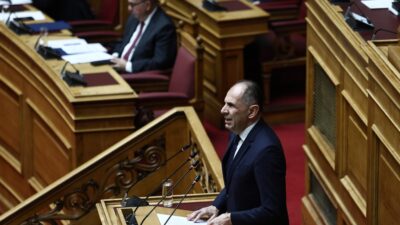Antonis Foskolos: An untold treasure awaits extraction from the Greek seabed
14/09/2020
In the Eastern Mediterranean basin, which has a size of about 1/3 of Saudi Arabia (figure 1), according to reasonable estimates, lies an untold treasure. Geographically it is divided into three areas: The first division is the Levantine basin and includes the EEZs of Syria, Lebanon, Israel and the eastern part of the Cyprus EEZ (plots 2, 3, 9, 12 and 13).
In this basin, mainly in the Israeli EEZ, 460 boreholes were drilled and gas deposits containing 1.5 trillion cubic meters (m3) were found of natural gas and 3 billion barrels of oil. In this area, the US Geological Survey estimates that there are but 3.5 trillion m3 of natural gas. Respectively, the Geological Survey of Israel estimates that there are another 8 trillion m3 of natural gas and 26 billion barrels of crude oil.
The second area includes the Nile Cone, which lies exclusively within the Egyptian EEZ belongs exclusively. About 1900 drillings were made in this area and 1.8 trillion m3 of natural gas were found without taking into account the “Zor” deposit which geologically belongs to the third area. The US Geological Survey (USGS Technical Report 2010) estimates that there are another 9 trillion m3 of natural gas in this area.
The third area includes the Mediterranean Ridge. The Mediterranean Ridge starts from the gulf of Kyparissia in Greece and ends at the ascent of Eratosthenes, ie south of Limassol in Cyprus. It essentially includes 3/4 of the Cypriot EEZ, a very small part of the Egyptian EEZ, where the “Zor” deposit is located, the entire area south of the Dodecanese and the entire Libyan Sea (southern Crete and the Libyan Sea).
Drilling in this area started in September 2015. Three drillings were made in coral reefs, namely in “Zor” (Egypt) and “Onisiforos” and “Kalypso” (Cyprus). 1.1 trillion m3 of natural gas were found. It was a great success. In this pristine area located west and southwest of Crete, the work of PGS and EDEY (Hellenic Hydrocarbon Management Company) identified 16 coral reef targets with exactly the same characteristics as the coral reefs, which were discovered in Cyprus.
The area of the reefs amounts to 3,310 km2. “Zor” with a reef area of 100 km2 has 0.8 trillion m3 of natural gas. Given that the coral reefs are very similar, if we have the same fullness, something that the drillings will show, the expected reserves should be of the order of 26.48 trillion m3 of natural gas. If we add the reserves of the gulf of Kyparissia (0.5 trillion m3) then the total according to the calculations should amount to 27 trillion m3.
Untold treasure in the Eastern Mediterranean
The very probable gas reserves of the Eastern Mediterranean basin – always according to estimates – amount to a total of 48 trillion m3. The distribution by country is as follows:
- Greece 27 trillion m3
- Cyprus (according to Spectrum) 4 trillion m3
- Israel (according to its own Geological Survey) 8 trillion m3
- Egypt (according to the US Geological Survey – USGS Technical Report 2010) 9 trillion m3.
It is noted that gas reserves in the intermediate space between Crete and Cyprus, ie south of the islands of Kasos, Karpathos, Rhodes and Kastellorizo are not included. Natural gas reserves in the Ionian, inland Western Greece and in the Thermaikos Gulf are also not taken into account. 80% of these quantities are exportable to Europe, the Far East and the USA, even if the latter seem impossible at the moment.
The above estimates do not include the gas deposits that exist in the bay of Sirte and very close to the sea plots southwest of Crete. The exploitation of these deposits will be undertaken by the consortium ExxonMobil, Total and ELPE. This amount of 48 trillion m3 of natural gas makes the Eastern Mediterranean basin the largest natural gas basin in the world.
If the estimates are confirmed, the natural gas reserves of Cyprus and Greece amount to 31 trillion m3. This will be proven by the drillings when they are done by the companies (figure 2). For comparison and because the cubic foot is also used as a measure, we note that an m3 is just over 35.315 cubic feet.
Russia’s potential competitor
If the estimates are confirmed in practice, the fact that a very large part of these quantities of gas will potentially go to the European market, makes us potential competitors of Russia. More specifically, the area of 10 targets in the two huge plots that have been granted to the consortium ExxonMobil, Total and ELPE is 2,000 km2 (as much as the prefecture of Chania), which is 20 times larger than the target of the “Zor” deposit.
If these targets have the fullness in natural gas that the targets of the “Zor” and “Kalypso” deposits have, then the expected quantities will be of the order of 16 trillion m3, ie more natural gas than the cumulative EEZs of Egypt and Cyprus have. According to estimates, the worst case scenario is that the quantities of natural gas in these two areas do not amount to16 trillion m3, but only to 2 trillion m3.
Let us also assume that the quantities of natural gas in block 10 (Gulf of Kyparissia, the rights of which have been given to the ELPE-Edison consortium) are 0.5 trillion m3 and in block 2 west of Corfu (consortium Total, Edison and ELPE) is 0.3 m3, if the companies’ estimates are valid, we can potentially export 45 billion m3 annually to the EU for at least 35 years (Figure 2).
The remaining amount of 1.2 trillion m3 will allow us to export another 40 billion m3 per year for 30 years in the form of liquefied natural gas. One idea is to liquefy the gas on the island of Gavdos (figure 3) and export it by LNG ships around the world. ExxonMobil and QatarOil are oriented towards this solution for the natural gas of Cyprus.
Huge investments
The investments needed to bring the deposits into production are huge. For every 1 trillion m3 of gas investments of the order of 4 billion dollars are needed. If all 16 targets shown by EDEY south of Crete have the same fullness in natural gas that the “Zor” field has, then the investments that companies will have to earmark to bring deposits into production are in excess of $ 100 billion
Much is being said by the government about investments, but the great growth in Greece will come from the investments that will be made mainly in the deposits. Only very large oil companies can raise this amount of investment capital, expecting, of course, profits many times the capital invested. The quantities of gas that can be channeled to Europe by EastMed, if the project is implemented, the ARF and the so-called Central-Med will amount to 75 billion m3 per year (Figure 4).
This amount can easily increase to 100 billion m3 per year, meeting the future needs of the EU’s growing demand. In his statements on 12/02/2018, Commissioner Miguel Caniete had estimated the increase in EU gas needs from 70% to 83% by 2040, ie a further increase of about 100 billion m3 per year.
Oil fields at greater depths
Beneath the natural gas deposits of Crete, which are found in the first 4,000 meters (Miocene) under the seabed, there are – in proportion to what Israeli geologists expect – deposits of other hydrocarbons. These are mainly gaseous hydrocarbons and crude oil at greater depths and in the sediments of the Oligocene, Eocene, Paleocene, and all sediments of the Mesozoic (Figure 5).
If Israel believes that its EEZ holds 26 billion barrels of crude oil in the Mesozoic sediments, then by analogy, because we are in the same basin, there must be maybe 75 billion barrels under Crete. This possibility should be the subject of new geophysical research by EDEY.
If, therefore, it is confirmed, by drillings, that the natural gas reserves in Crete are of the order of 27 trillion m3, then the value of the deposits – based on prices that were valid in normal periods – will be of the order of $ 7 trillion. According to the Maniatis law (4001/2011) 20% of the value of the deposits is taken by the state, ie about $ 1.4 trillion and 5% of the value is taken by the region, ie $ 350 billion.










